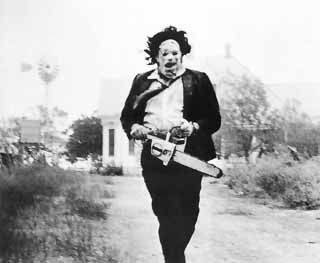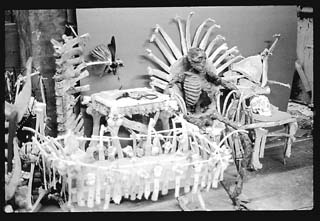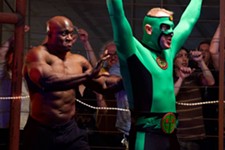The Buzz Heard 'Round the World
By Marc Savlov, Fri., Oct. 30, 1998
|
|
In the 24 years since its initial release, The Texas Chainsaw Massacre has achieved legendary status in the Pantheon of the Intense. Directed and co-written by Tobe Hooper, the low-budget film was shot in and around the Austin area. Since 1974, Chainsaw has been graced with the ironic distinction of achieving not only a permanent residence in the Museum of Modern Art's film library but also the nightmares of filmgoers everywhere. Ed Neal's birthmarked lunatic scared off a generation of post-Sixties flower children from the joys of hitchhiking, and an underappreciated work implement became an instant, must-have Halloween accouterment. And rural summer sausage sales? Don't even ask.
Since then, Hooper has been working on a steady stream of genre-related projects, from Poltergeist to the underrated Invaders From Mars, and The Texas Chainsaw Massacre 2 to the recent Stephen King adaptation, The Mangler. Through it all he's managed to mix humor and horror in equal doses, a combination that sometimes leaves audiences (not to mention critics) scratching their heads, unsure whether to laugh or scream. I had the opportunity to chat with Hooper from his home in Los Angeles (although the director has recently purchased property in Austin, where he plans on spending most of his time between projects), and discussed Chainsaw, true-life horrors of the MPAA, and the new wave of Hollywood horror films. Hooper will present The Texas Chainsaw Massacre this Friday, October 30 at the Alamo Drafthouse as a benefit screening for the Austin Film Society.
Austin Chronicle: It's been 24 years since The Texas Chain Saw Massacre was released, and in that time it's become somewhat of a cultural and cinematic landmark. Did you have any inkling way back when that it would become as universally iconic as it has?
Tobe Hooper: It's bigger than I ever imagined. I knew when I was shooting it that it was special because everything that was happening led me to that conclusion, both in the shooting and in the genesis of the project. Those feelings were based on what was in the marketplace and what I had seen (and I had seen practically everything). I had a good feeling about it at the time, about it being a film that would get lots of play dates and basically get another job for me. In that respect, I knew it was special because I knew that there was nothing like it, but no, there was no way of anticipating that it would become a title as important as Gone With the Wind.
AC: Did it take off immediately or did it take some time for the film to gather that momentum?
|
|
AC: Did you end up making any money off of the film, or was this another example of a groundbreaking indie filmmaker ending up holding an empty bag?
TH: Oh yeah. I was definitely screwed around when it comes to that. I didn't make any money on it.
AC: Chainsaw has been compared to Hitchcock's Psycho in the sense that people looking back on it seem to recall these ghastly scenes of bloodshed that in reality just aren't there. Both films achieve their frisson via subtle editing tricks and an overall tone of unrelenting intensity, without ever actually crossing over into the gory cheap shots. Is this something you intentionally strove to go for, this sense of horror by implication?
TH: I was very selective in shooting the film. We had that one scene where they hang the girl on the meat hook, right? I wanted the film to get a rating, and in my naïveté I hoped to get a PG rating. I knew that in film theory that tantalizing the audience with the promise of an image, and then getting around it editorially, allows everything to happen in the mind. We fill in the blank, I think, with much more serious information than we could have seen anyway.
So what happened was that I was constantly calling the MPAA while I was shooting the film and in particular I was asking, "How do I get a PG rating and then hang a girl on a meat hook?" And then there was a long silence. I started tap-dancing, then, and I said, "Look, if you don't see penetration, if you don't see blood, can it be implied?" And they said yes. Of course, the way you see it in the finished film is you see the girl coming toward the meat hook with it in the foreground, and then it cuts around. There's dried blood in the background from other meat hook hangings, but as soon as she's struggling on the hook, the camera tilts down under her feet and comes to rest on a big washtub. And you know immediately what that's meant to do: not to ruin the carpet and minimize the clean-up. I ended up planting visual tricks like that all the way through. It's amazing, because that with the title combined makes it in some people's minds as the goriest film they've ever seen. In terms of quantity, though, it could fit in a test tube. [Ed. Note: Chain Saw received an R rating from the MPAA.]
AC: So many people have their own favorite scenes in Chain Saw. I'd like to know what you consider the best bits in there. What do you look back on and think, "Damn, I really nailed it with that one?"
TH: The meat hook scene and the build-up to it is certainly one of the scariest things in there. When the camera dollies under the swing as the girl (played by Teri McMinn) gets up and approaches the house...you see that her back is exposed all the way down ñ that's one of my favorite scenes. I also like the dinner table scene a lot because it allowed me to work inside this bizarre, comedic sequence that had a ring of truth to it. And it was so damn weird and bizarre that it could go way out on the edge and turn into comedy. However, I think that scene, coming late in the film, it did take a long time for some people to see the comedy in it. It was outrageous, and certainly that's also one of my favorite scenes.
AC: So many directors these days are returning to their classic works and tinkering with them, adding scenes, changing things and whatnot, for laserdisc and DVD releases. Is this something you plan to do with Chain Saw?
TH: There is a new laserdisc out from Elite, and to the degree it's possible, what they've done is digitize the original and cleaned it up somewhat. They've also processed the sound into stereo. I had the opportunity of making the color balance right as well, but there wasn't any cutting of the film. In fact, there was only one cut of the film made originally, and there were no deletions made by the MPAA, so there wasn't much to go back to. What they did on the laserdisc is add some supplemental footage and sequences that never made it into the original. There are scenes that I had re-shot, there were several scenes where the lens was bad ñ back in those days, shooting in Austin, you didn't have dailies, you had weeklies, and it was not at all like it is now. So Elite found this footage and stuck it on the laserdisc.
AC:How do you respond to conservative critics who occasionally mention Chain Saw as one of those films which engenders a sense of violence in kids and contributes to the general breakdown of society?
TH: You know, the times were so different then. I didn't have a feeling of cause and effect, it wasn't even in my lexicon of life, you know? There was a period of time when the Friday the 13th films came out ñ and I'm not zeroing in on those films specifically ñ but there were some films that came out that were strictly for the violence and the gross-out and so on. I don't feel responsible for causing any real damage to the psyche, but the times were just so different back then. What can I say?
|
|
AC: The Texas Chainsaw Massacre 2: I enjoyed that one very much, although it's really taken a critical drubbing over the years. How did the notion of a sequel come about? Was it something you had been planning on doing, was there a call for it, was it a purely monetary move? How did that come about?
TH: I had just signed a three-picture deal and I was slated to produce that movie, and instead they made the deal sweeter and I came on board as director. I'll be honest: I feel that that film came out of my frustration at the comedy in the first film not being appreciated or understood. And so I amplified the comedic aspects of it, but at the same time [effects master] Tom Savini made everything so anatomically correct and cost so much, that, you know, the film ended up not even getting a rating. I like the film as this wacky, crazy, bizarre, over-the-top dark comedy, but it missed its mark in doing what the audience expected it to do, which was to scare the hell out of them and give them a little more of what they had experienced in the first film. One of the flaws in the film is that unfortunately too much time was spent with the chainsaw family. You got to know the family and their insanity too well and it demystified the potential horrific elements. I like that film, too, but I have to say that it certainly isn't the quintessential sequel. It was part of a deal commitment, and I had fun doing it to the detriment of the film itself. Sometimes we do things for the wrong reasons.
AC:Have you had a chance to see Kim Henkel's recent updating [Texas Chainsaw Massacre: The Next Generation]?
TH: I've seen it on video.
AC:Any comments?
TH: Once again, I think it missed the mark. It got too close to the family and it was funny, but not scary. Back to my perspective on the feelings that I had on Chainsaw 2, it was a bit indulgent and not really thought through.
AC:What do you think of the current crop of horror films that have come down the pike of late? I'm speaking specifically of Scream, I Know What You Did Last Summer, and so on.
TH: I think it's terrific. I'm a fan of Scream and Scream 2, and I'm a legitimate fan, not just because Wes [Craven] is a friend. One thing that I thought was really interesting about Scream was that because Wes had so much trouble getting a rating for the film (I think he ended up submitting it to the MPAA five times in all), it pushed it back past the scheduled Halloween opening into the holiday season and we ended up finding a new time to release horror films.
I went to see the first paying screening and there were about 30 people in the theatre and thought the whole thing was pretty damn cool, you know? It did what it promised to do. And then word of mouth turned it into the mega-hit that it eventually became. And the cycle has started again. I'm anxious to see Robert Rodriguez's new film, The Faculty. I've been hearing on the grapevine that some of the CGI work on the film is going to be really cool. Can't wait to see that.
AC:I was talking to Wes Craven about Scream several months before it was initially released and while telling me about all his MPAA problems he mentioned that they don't actually give you a list of what they might want deleted, they only kind of pussyfoot around it. In other words, they can object to "the tone" of the film, and get away with leaving the director and editor in the dark, which, of course, makes it that much more problematic when it comes to securing the all-important R rating.
TH: That's correct. You have to read their minds. And I think that Wes was quite right in his assessment of it when he said that it was the "intensity" of the film more so than the specifics. In other words, they wanted the volume turned down on the whole thing.
AC: What are you working on now?
TH: The last couple of years I've done three TV pilots in a row that got picked up as series [Dark Skies, Nowhere Man]. I've completed a dark comedy called The Apartment Complex. We had to build this apartment complex which, in the context of the film, was supposedly designed by Frank Lloyd Wright's idiot cousin. It's about a young man coming to do his master's in psychology at UCLA. He sees an ad to be the manager of an apartment complex rent-free, and he falls into this weird Hollywood happening inside this weird, Caligari-esque apartment complex. It's really cool. It has Chad Lowe, Fay Masterson from Eyes Wide Shut, Patrick Warburton from Seinfeld, Jon Polito, Miguel Sandoval, Tyra Banks, R. Lee Ermey, Amanda Plummer. It's a great cast. It's what they call a backdoor pilot for Showtime.
AC:Finally, if The Texas Chainsaw Massacre was to be released today, do you think it could get away with anything other than an NC-17 rating?
TH: You know, I think it might be an R. Maybe I'm only hoping that, it could be that's just a wish, but in Scream there is a lot more violence and a lot more blood.
AC: Scream is that much more self-referential, though; it has its tongue planted firmly in cheek, whereas Chain Saw – for all the weird humor you've got in it – the overall tone is very disturbing. In all the best ways, certainly, but disturbing nonetheless.
TH: It may be. You may be right. We'll never know.
The Austin Film Society will present The Texas Chain Saw Massacre on Friday, October 30 with director Tobe Hooper in attendance to discuss the film. Screenings are at 9:30pm and midnight. Hooper will be introduced by Harry Knowles. Special collector's edition posters will also be available for Hooper to sign. The event is co-sponsored by The Austin Chronicle. The screenings benefit the Austin Film Society. Tickets are $10 for AFS members; $12 for the general public. For more info, call 322-0145 or visit http://www.tobehooper.com.











